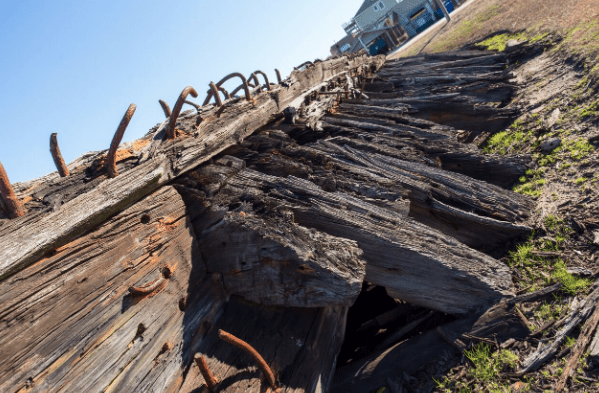The shipwreck that has come to rest beside the Nags Head Town Hall is now just a skeleton, the bones of the ship that once plied the ocean off the coast of North Carolina.
It had been a part of the Nags Head beach for some time before it found a home at Town Hall, alternately appearing then disappearing based upon the vagaries of wind, tide and sand. In 1978, a storm freed the wreck from the sand and it once again was afloat upon the sea—unfortunately in this case, floating into Jennette’s Pier, which was a wooden structure at that time.

After the storm, Nags Head brought the wreck back to the Town Hall, where it has remained until today.
Initial research on the vessel indicated it was the Francis E. Waters, a two-masted schooner that sunk on October 23, 1899.
By 1899, the US Lifesaving service was a professional organization with real pride in the ability of its crews to effect rescues of foundering ships. Nonetheless, they could not be at all places at all times, and it appears as though the Francis E. Waters slipped unnoticed to its watery grave.
No one saw the ship sink, and it was not until the following morning that the wreck was found, hull down on the beach.
According to the Life-Saving Station Nags Head report that was filed at the time, the ship had sailed with a crew of six from from Georgetown, South Carolina to Philadelphia with a load of shingles. None of the crew survived.
Responding to the question, “Supposed cause of wreck (specifying particularly)…” Station Master VB (Van Buren) Etheridge wrote, “Gale wind anchored back of the reaf (sic) & rolled over.”
The storm was the tail end of a hurricane that had been reported in the Caribbean earlier in the month. Although no longer packing hurricane force winds, it was still a powerful storm, pushing the surf over the beach, making the foot patrols that were often the first warning of a sinking vessel near impossible.
Surfman No. 5 Elisha Twine had the midnight to 3 a.m. patrol and he “…stated that he saw lots of sumthing (sic) drifting in the surf…but the night was so dark he could not tell but very little about what it was.”
When the Nags Head Surfmen came on the site of the shipwreck, it was apparent there was little that could be done.
“We all went on to the wreck and found her bottom up in the surf at the beach a totle (total) wreck. We looked along the beach for drowned bodies was all we could do. We found one man in the rigging that was hanging to one of the mast. We tuck [sic] him to the station and made a box and Buried him,” Etheridge wrote.
The story of the sinking of the Francis E. Waters gives a harrowing sense of the dangers of sailing along the coast of North Carolina.
Unfortunately, the bones of the ship that rests beside Nags Head Town Hall, may not be—probably is not— the Francis E. Waters.
In 2014, a new study of the wreck was initiated under the supervision of Dr. Nathan Richards, who at the time was the head of Maritime Studies at the Coastal Studies Institute. What the study concluded was that the shipwreck seemed larger than the dimension of the Francis E. Waters and that the ship had been misidentified.
The researchers pointed to two other possibilities—the Florence Randall and Thomas Goddard.
The Florence Randall foundered on August 16, 1899, probably a victim of the San Ciriaco Hurricane, the longest lasting hurricane ever recorded. The hurricane battered the Outer Banks as a class three storm.
The ship sank off Avon, about 50 miles south of Nags Head.
At the time the area was known as Kinakeet, and the Station Kinakeet Lifesaving crew were able to rescue all eight crew members.
Although south of Nags Head, it is possible that the shipwreck drifted north over the years.
The Thomas Goddard sank during a nor’easter on December 9, 1905 between Kill Devil Hills and Nags head. Described as a three-masted schooner barge, the crew of five was rescued.
During the rescue, VB Etheridge, who was the senior lifesaving surfman, noted that “…she struck the beach with terrific force, the heavy sea making a clean breech over her…” and that a week later “…she continued to break up and soon became a mere hulk.”
According to the ECU team, it is possible that the shipwreck could be any of the three—the Francis E. Waters, Florence Randall or Thomas Goddard—but none of the ships seem to match what the researchers found in studying the history and dimensions of the wrecks.
